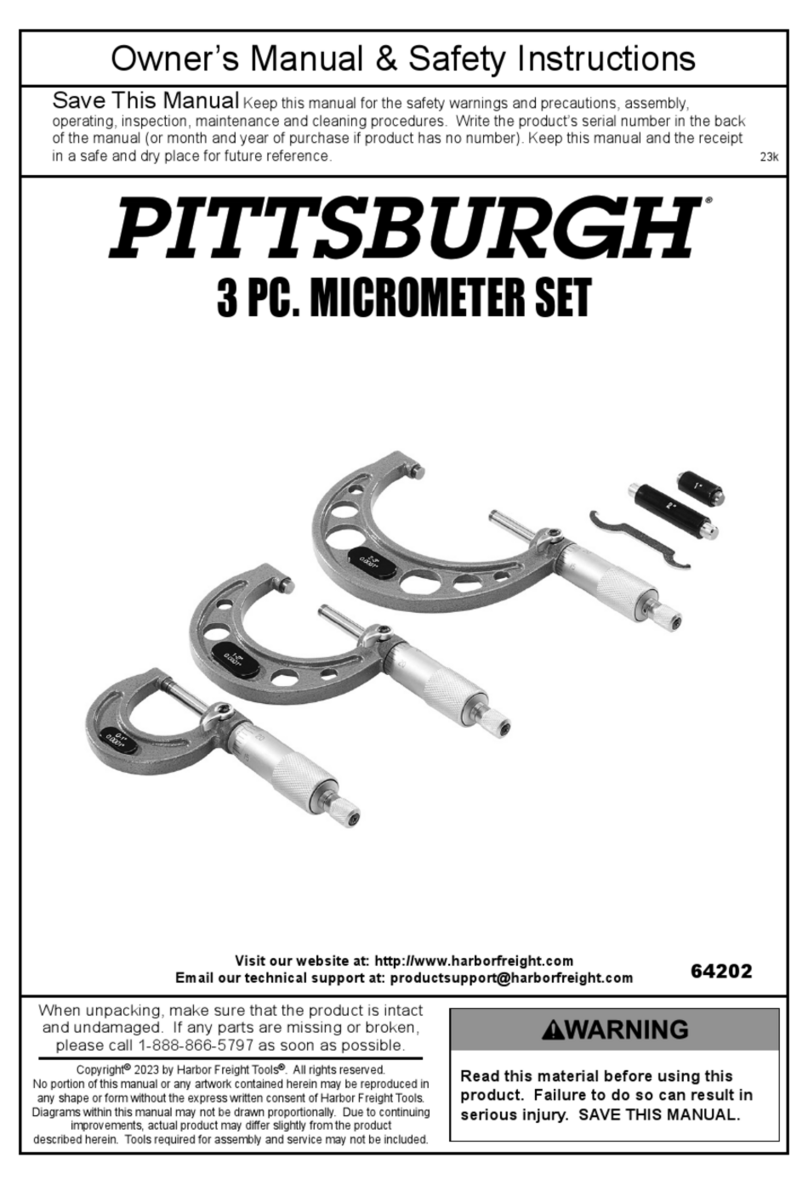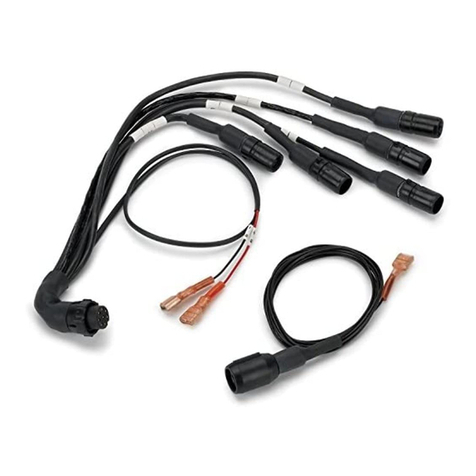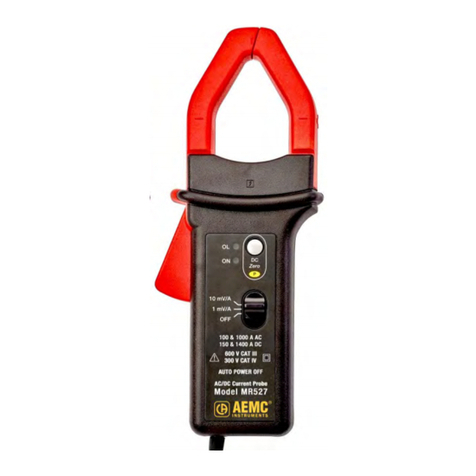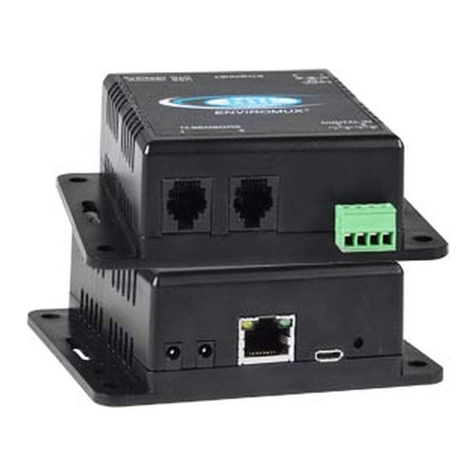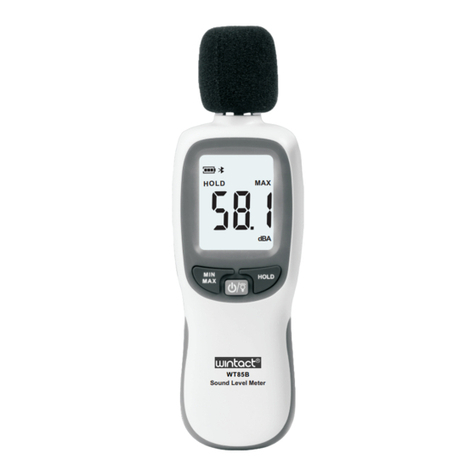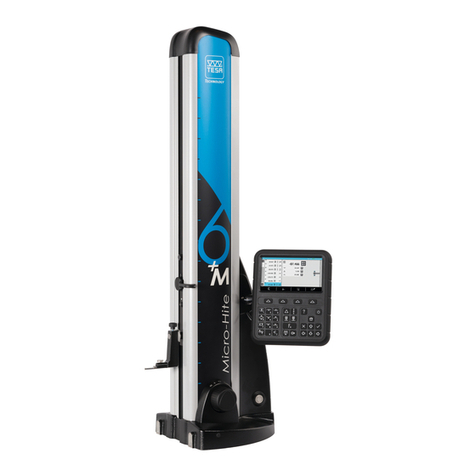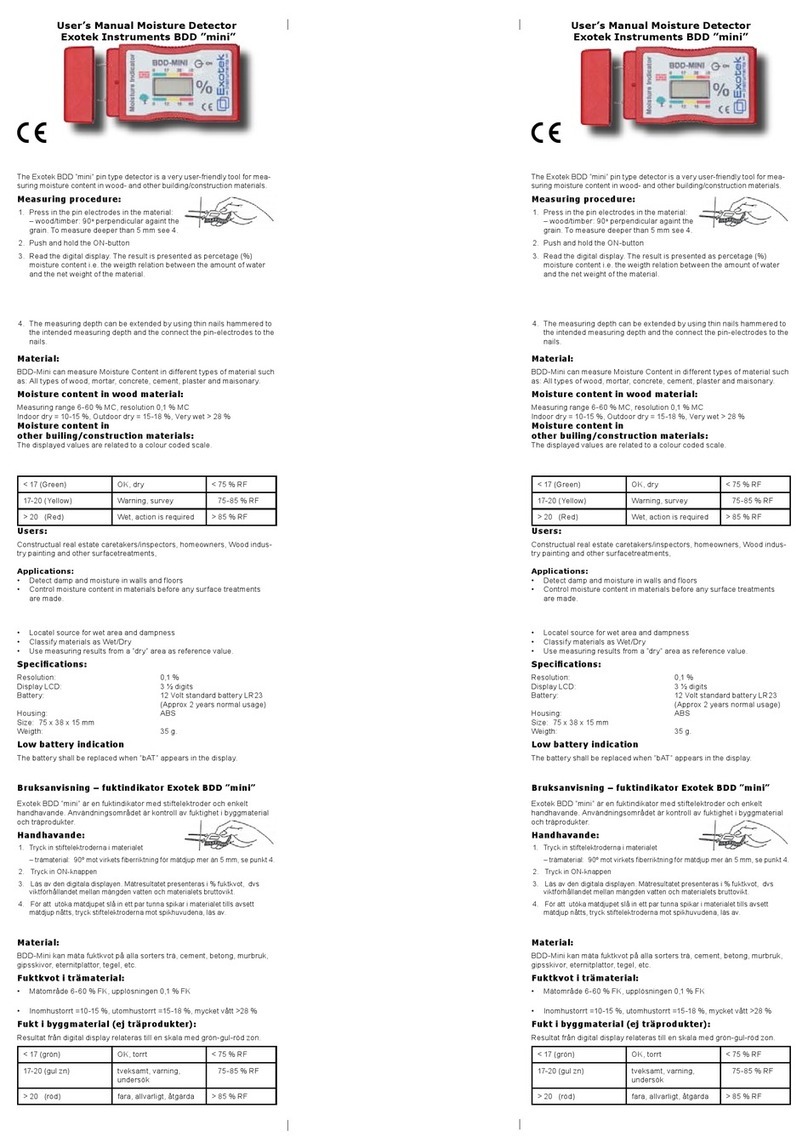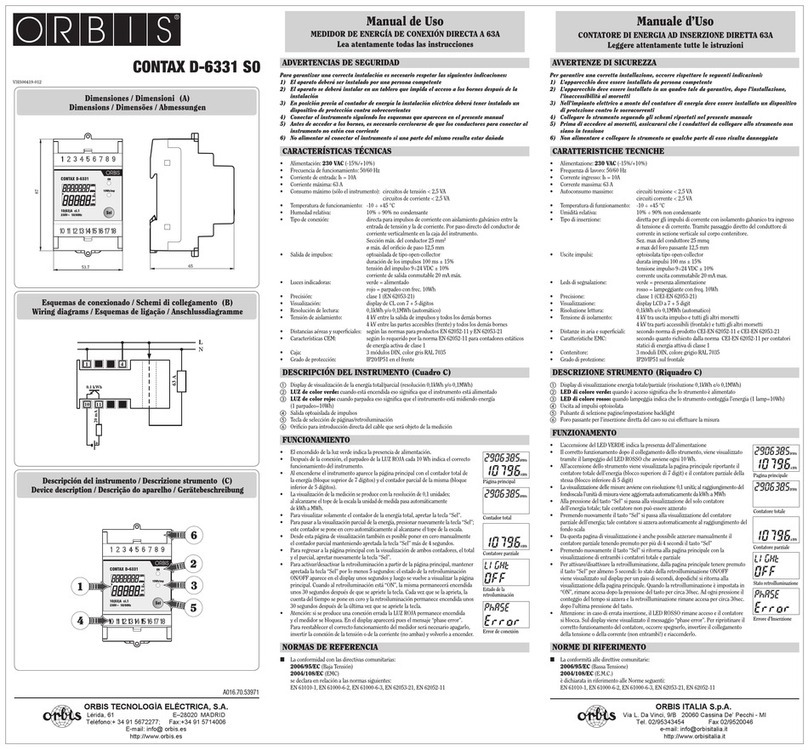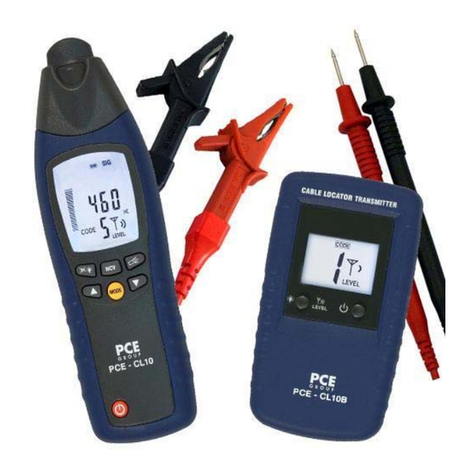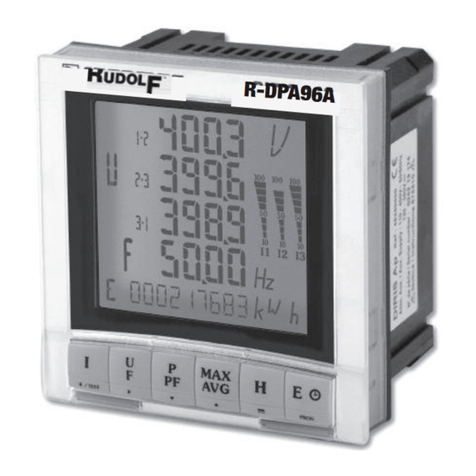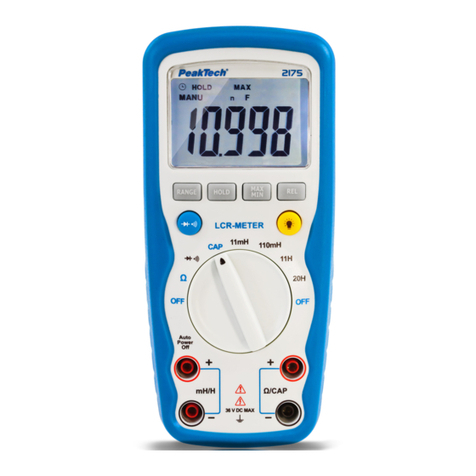GLI International P33 Instruction Manual

Rev. 6-1100 Model P33 pH/ORP Analyzer (panel-mount 1/4 DIN)
1
OPERATING INSTRUCTION MANUAL
Model P33
pH/ORP Analyzer
(Panel-mount 1/4 DIN style;
selectable for pH or ORP measurement)
Worldwide Headquarters and Sales:
GLI International, Inc.
9020 West Dean Road
Milwaukee, Wisconsin 53224
U.S.A.
Represented By:
In the interest of improving and updating its equipment, GLI reserves the right to alter specifications to equipment at any time.
A company
Viridor Instrumentation
Phone:
Fax:
E-mail:
Web:
[414] 355-3601
[414] 355-8346
info@gliint.com
www.gliint.com

Model P33 pH/ORP Analyzer (panel-mount 1/4 DIN) Rev. 6-1100
2
This operating instruction manual and other GLI instruction
manuals are available on GLI’s web site at gliint.com.
when viewed using Adobe’s free Acrobat reader. To get
this reader, link to Adobe through GLI’s web site or visit
Adobe’s web site at adobe.com.

Rev. 6-1100 Model P33 pH/ORP Analyzer (panel-mount 1/4 DIN)
3
IMPORTANT SAFETY INFORMATION
This analyzer is compliant with safety standards as outlined in:
FMRC Class Numbers 3600, 3611, and 3810 (U.S.A.)
CSA C22.2 No. 142 and C22.2 No. 213 (Canada)
EN 61010-1 (European Community)
Please read and observe the following:
•Line voltage may be present at terminals on TB1 at the back of the analyzer enclosure. This may be
hazardous. Always remove line power before going near this area of the analyzer. The front bezel
assembly of the analyzer, however, contains only low voltage and is completely safe to handle.
•Wiring or repairs should only be performed by qualified personnel and only to an unpowered analyzer.
•Whenever it appears that analyzer safety is questionable, disable the analyzer to ensure against any
unintended operation. For example, an unsafe condition is likely when:
1) The analyzer appears visibly damaged.
2) The analyzer fails to operate properly or provide the intended measurements.
3) The analyzer has been stored for long periods at temperatures above 158°F (70°C).
•This analyzer must be installed by specially trained personnel in accordance with relevant local codes
and instructions contained in this operating instruction manual. Observe the analyzer’s technical
specifications and input ratings. If one line of the line power mains is not neutral, use a double-pole
mains switch to disconnect the analyzer.
HELPFUL IDENTIFIERS
In addition to information on installation and operation, this instruction manual may contain
WARNINGS pertaining to user safety, CAUTIONS regarding possible instrument malfunction,
and NOTES on important, useful operating guidelines.
WARNING:
A WARNING LOOKS LIKE THIS. IT WARNS YOU OF THE
POTENTIAL FOR PERSONAL INJURY.
CAUTION:
A CAUTION LOOKS LIKE THIS. IT ALERTS YOU TO POSSIBLE
INSTRUMENT MALFUNCTION OR DAMAGE.
☞
NOTE: A note looks like this. It alerts you to important operating
information.

Model P33 pH/ORP Analyzer (panel-mount 1/4 DIN) Rev. 6-1100
4
Definition of Equipment Symbols
This symbol means CAUTION and alerts the user to possible dan-
ger or instrument malfunction. Refer to this manual before
proceeding.
This symbol, which appears on the analyzer POWER terminal block
(shown in Figure 2-2), means that this is a protective ground
terminal and alerts the user to connect an earth ground to it.
This symbol means that there is alternating current present and
alerts the user to be careful.
WARRANTY
GLI International, Inc. warrants the Model P33 to be free from defects in material
or workmanship for a period of 2 years (24 months) from the date of shipment of
this product from our facility. A warranty claim will not be honored if defects are
not reported within the warranty period, or if GLI International determines that
defects or damages are due to normal wear, misapplication, lack of mainte-
nance, abuse, improper installation, alteration, or abnormal conditions. GLI
International’s obligation under this warranty shall be limited to, at its option, re-
placement or repair of this product. The product must be returned to GLI
International, freight prepaid, for examination. The product must be thoroughly
cleaned and any process chemicals removed before it will be accepted for re-
placement or repair. GLI International’s liability shall not exceed the cost of the
product. Under no circumstances will GLI International be liable for any inciden-
tal or consequential damages, whether to person or property. GLI International
will not be liable for any other loss, damage or expense of any kind, including
loss of profits, resulting from the installation, use, or inability to use this product.

Rev. 6-1100 Model P33 pH/ORP Analyzer (panel-mount 1/4 DIN)
5
CONDENSED OPERATING INSTRUCTIONS
This manual contains details for all operating aspects of the instrument. The following con-
densed instructions are provided to assist you in getting the instrument started up and
operating as quickly as possible. These condensed instructions only pertain to basic pH
measurement operation using a GLI Differential pH sensor.To measure ORP, or use a
conventional combination electrode or specific features of the instrument, refer to the appro-
priate sections in this manual for instructions.
A. CONNECTING SENSOR/CONFIGURING SENSOR TYPE AND TEMPERATURE ELEMENT
1. After properly mounting the analyzer (PART TWO, Section 2), connect the GLI 5-wire
Differential Technique pH sensor, matching wire colors to terminals as indicated:
Sensor Wire Colors Connect to SENSOR Terminal
Yellow #4 on TB3
Shield #5 on TB3
Black #6 on TB3
White #7 on TB3
Green #8 on TB3
Red #1 on TB4
2. The analyzer is supplied factory-set for use with the GLI 5-wire Differential Technique
pH sensor. When using a conventional combination electrode, you must change the
sensor type (see PART THREE, Section 3.2, subheading “SELECT SENSOR Type”).
3. The analyzer is supplied factory-set for automatic temperature compensation using the
NTC 300 ohm temperature element built into all GLI Differential sensors (except Model
6006P4-2000 high purity water pH sensor systems which use Pt1000 ohm RTD).
When using a sensor with a different temperature element, or if you want fixed
MANUAL temperature compensation, you must change the temperature element type
(see PART THREE, Section 3.2, subheading “Select TEMP ELEMENT Type”).
B. CONNECTING LINE POWER
Important: Follow instructions in PART TWO, Section 3.6 to connect line power to the analyzer.
C. CONFIGURING BUFFER TYPE/CALIBRATING THE ANALYZER
The analyzer must be calibrated so that measured values will correspond to actual process
values. Before calibrating for the first time, select the buffer value set that will be used.
Then, calibrate using the recommended “2 POINT BUFFER”method which will provide the
most accurate pH measurements.
1. The analyzer is supplied factory-set for the common 4.00, 7.00, and 10.00 pH buffers.
When using DIN 19267 standard value buffers you must change the buffer set (see
PART THREE, Section 3.2, subheading “SELECT BUFFER Set”).
(continued on next page)

Model P33 pH/ORP Analyzer (panel-mount 1/4 DIN) Rev. 6-1100
6
CONDENSED OPERATING INSTRUCTIONS
C. CALIBRATING THE ANALYZER -- (continued)
NOTE: When using buffers that are not included in either of the analyzer buffer sets,
use only the “2 POINT SAMPLE”method for calibration. Refer to that sub-
heading in PART THREE, Section 4.2 for instructions.
2. Immerse the sensor in the first buffer (preferably pH 7). Important: Allow the sensor
and buffer temperatures to equalize. Depending on their temperature differences, this
may take 30 minutes or more.
NOTE: An in-progress calibration can always be aborted by pressing the ESC key.
After the “ABORT: YES?”screen appears, do one of the following:
•
Press ENTER key to abort. After “CONFIRM ACTIVE?”screen appears,
press ENTER key to display the MEASURE screen, and return the ana-
log outputs and relays to their active states.
•
Use
×
×
or
Ø
Ø
key to choose “ABORT: NO?”screen, and press ENTER key
to continue calibration.
Calibration Tip! If, at any time during calibration, the “2 POINT BUFFER:
CONFIRM FAILURE?”screen appears, press ENTER key to confirm. Then, use the
×
×
or
Ø
Ø
key to select between “CAL: EXIT”or “CAL: REPEAT”and do one of the
following:
•
With the “2 POINT BUFFER: CAL EXIT?”screen selected, press ENTER key.
Then, after the “2 POINT BUFFER: CONFIRM ACTIVE?”screen appears, press
ENTER key to return the analog outputs and relays to their active states
(MEASURE screen appears).
•
With the “2 POINT BUFFER: CAL REPEAT?”screen selected, press ENTER key
to repeat calibration of this point.
3. Press MENU key to display a “MAIN MENU”screen. If the screen is
not showing, use
Ø
Ø
or
×
×
key to display it.
4. Press ENTER key to display .
5. Press ENTER key again to display .
6. Press ENTER key again to display .
7. Press ENTER key again to “hold”the analog outputs and relays at their present states
during calibration. (Outputs can also be transferred to preset values or allowed to re-
main active.)
(continued on next page)

Rev. 6-1100 Model P33 pH/ORP Analyzer (panel-mount 1/4 DIN)
7
CONDENSED OPERATING INSTRUCTIONS
C. CALIBRATING THE ANALYZER -- (continued)
8. With the sensor in the first buffer and the screen displayed, press
ENTER key to confirm. While the screen is displayed, the analyzer
waits for the pH and temperature signals to stabilize, measures the buffer value, and
automatically calibrates this point. Thereafter, a screen like appears
for 5 seconds to confirm calibration of this point.
NOTE: Any time the “PLEASE WAIT”screen is displayed during calibration, you can
manually complete calibration of the point by pressing the ENTER key. How-
ever, this is not recommended because the pH and temperature signals may
not be fully stabilized, resulting in an inaccurate calibration.
9. After the screen appears, remove the sensor from the first buffer,
rinse it with clean water, and immerse it in the second buffer (typically pH 4).
10. Press ENTER key to confirm. While the screen is displayed, the
analyzer waits for the pH and temperature signals to stabilize, measures the buffer
value, and automatically calibrates this point. Thereafter, a screen like
appears for 5 seconds to confirm calibration of this point.
11. A “pH SLOPE XX.X mV/pH”screen appears, indicating a slope value to measure sen-
sor performance. The slope should be within 54 to 62 mV/pH for optimal performance.
12. Press ENTER key to end calibration (“2 POINT BUFFER: CONFIRM CAL OK?”screen
appears).
13. Re-install the sensor into the process.
14. Press ENTER key to display the active measurement reading on the “2 POINT
BUFFER: CONFIRM ACTIVE?”output status screen. When the reading corresponds
to the actual typical process value, press ENTER key again to return the analog out-
puts and relays to their active states (MEASURE screen appears).
This completes “2 POINT BUFFER”calibration. The analyzer is now ready to measure pH.
D. COMPLETING ANALYZER CONFIGURATION
To further configure the analyzer to your application requirements, use the appropriate
CONFIGURE screens to make selections and “key in”values. Refer to PART THREE, Sec-
tion 3 for complete configuration details.

Model P33 pH/ORP Analyzer (panel-mount 1/4 DIN) Rev. 6-1100
8

Rev. 6-1100 Model P33 pH/ORP Analyzer (panel-mount 1/4 DIN)
9
TABLE OF CONTENTS
PART ONE - INTRODUCTION
SECTION 1 GENERAL INFORMATION
1.1 Capability Highlights ........................................................................15-16
1.2 Modular Construction .......................................................................16-17
1.3 Retained Configuration Values .............................................................17
1.4 Analyzer Serial Number ........................................................................17
1.5 EMI/RFI Immunity..................................................................................17
SECTION 2 SPECIFICATIONS....................................................................................18-19
PART TWO - INSTALLATION
SECTION 1 UNPACKING.................................................................................................20
SECTION 2 MECHANICAL REQUIREMENTS
2.1 Location.................................................................................................20
2.2 Mounting...........................................................................................20-21
SECTION 3 ELECTRICAL CONNECTIONS
3.1 GLI 5-wire Differential Technique Sensor ........................................22-24
3.2 Conventional Combination Electrode...............................................24-25
3.3 Conventional Combination Electrode with Ground Rod ........................25
3.4 Analog Outputs......................................................................................26
3.5 Relay Outputs........................................................................................27
3.6 Line Power ............................................................................................28
PART THREE - OPERATION
SECTION 1 USER INTERFACE
1.1 Display ..................................................................................................29
1.2 Relay A and B Indicators.......................................................................29
1.3 Keypad .............................................................................................29-30
1.4 MEASURE Screen (normal display mode)............................................31
SECTION 2 MENU STRUCTURE
2.1 Displaying Main Branch Selection Screen ............................................32
2.2 Displaying Top-level Menu Screens......................................................33
2.3 Displaying Submenu Screens ...............................................................34
2.4 Adjusting Edit/Selection Screen Values ................................................34
2.5 Entering (Storing) Edit/Selection Screen Values/Choices.....................34

Model P33 pH/ORP Analyzer (panel-mount 1/4 DIN) Rev. 6-1100
10
TABLE OF CONTENTS (continued)
SECTION 3 ANALYZER CONFIGURATION
3.1 Selecting LANGUAGE to Operate Analyzer.......................................... 35
3.2 Configuring Sensor Characteristics:
SELECT SENSOR Type .............................................................35-36
Select DISPLAY FORMAT...............................................................36
SELECT BUFFER Set for pH Calibration ........................................37
Select PURE H2O COMP (for special applications) ...................37-38
SET ISO POINT (isopotential for special Differential pH sensor) ........38
SET FILTER Time.......................................................................38-39
Select PULSE SUPPRESS (on/off)..................................................39
ENTER NOTE (top line of MEASURE screen)............................39-40
Select TEMP ELEMENT Type ....................................................40-41
3.3 SET °C OR °F (temperature display format) .........................................41
3.4 Configuring Analog Outputs (1 and 2):
SET PARAMETER (representation) ................................................42
SET 0/4 and 20 mA VALUES......................................................42-43
SET TRANSFER Value (mA) ........................................................... 43
SET FILTER Time............................................................................44
Select SCALE 0 mA/4 mA (low endpoint) ........................................44
3.5 Configuring Relays (A and B):
SET PARAMETER (representation) ................................................45
SET FUNCTION Mode (alarm, control or status)........................45-46
SET TRANSFER Mode (relay on or off) ..........................................46
ACTIVATION (configuration values) ...........................................47-48
3.6 SET PASSCODE (feature enabled or disabled) ...................................49
3.7 Configuration Setting Summary (ranges/choices and defaults) .......50-51
SECTION 4 ANALYZER CALIBRATION
4.1 Important Information:
Calibrate Periodically.......................................................................52
Temperature-corrected pH Measurement........................................52
4.2 pH Calibration:
2 POINT BUFFER Method..........................................................53-55
1 POINT BUFFER Method..........................................................55-57
2 POINT SAMPLE Method..........................................................57-59
1 POINT SAMPLE Method..........................................................60-61
4.3 ORP Calibration ...............................................................................62-63
4.4 Analog Outputs (1 and 2) Calibration...............................................63-64

Rev. 6-1100 Model P33 pH/ORP Analyzer (panel-mount 1/4 DIN)
11
TABLE OF CONTENTS (continued)
SECTION 5 TEST/MAINTENANCE
5.1 STATUS Checking (analyzer, sensor, and relays)...........................65-66
5.2 HOLD OUTPUTS ..................................................................................67
5.3 OVERFEED RESET (relay timers) ........................................................67
5.4 OUTPUT (1 and 2) Analog Test Signals ...............................................68
5.5 RELAY (A and B) Operating Test.....................................................68-69
5.6 ALARM LEDS Operating Test...............................................................69
5.7 EPROM VERSION Checking ................................................................69
5.8 SELECT SIM Measurement ..................................................................70
5.9 SIM Setting............................................................................................70
5.10 RESET CONFIGURE Values to Factory Defaults.................................71
5.11 RESET CALIBRATE Values to Factory Defaults ..................................71
SECTION 6 RELAY OVERFEED TIMER FEATURE
6.1 Why Use an Overfeed Timer.................................................................72
6.2 Configuring Relay Overfeed Timers......................................................72
6.3 Overfeed Timer “Timeout”Operation ....................................................72
6.4 Resetting Overfeed Timers ...................................................................72
6.5 Interactions with Other Analyzer Functions......................................72-73
SECTION 7 HART OPTION
7.1 Introduction ...........................................................................................74
7.2 Analyzer Operating Modes for HART Network.................................75-76
7.3 SINGLE MODE (Point-to-Point) Wiring Arrangement ...........................76
7.4 MULTI-DROP Wiring Arrangement.......................................................77
7.5 HART Preferences Setup:
Changing Polling Address ...............................................................78
Viewing Number of Required Preambles ....................................78-79
7.6 Device Preferences Setup:
Viewing Final Assembly Number .....................................................79
Viewing Model Number ...............................................................79-80
Viewing Manufacturer ......................................................................80
Assigning a Tag ...............................................................................80
Assigning a Descriptor.....................................................................81
Assigning a Message.......................................................................81
Assigning User-defined Date ......................................................81-82
Viewing Identification (ID) ................................................................82
Viewing Revisions............................................................................82
7.7 “Master Reset”Function........................................................................83
7.8 “Refresh”Function ................................................................................83
7.9 Protocol Command Set for PC Programming........................................83

Model P33 pH/ORP Analyzer (panel-mount 1/4 DIN) Rev. 6-1100
12
TABLE OF CONTENTS (continued)
PART FOUR - SERVICE AND MAINTENANCE
SECTION 1 GENERAL INFORMATION
1.1 Inspecting Sensor Cable .......................................................................84
1.2 Replacing Fuse(s) ............................................................................84-85
1.3 Replacing Relays ..................................................................................85
SECTION 2 PRESERVING MEASUREMENT ACCURACY
2.1 Keeping Sensor Clean ..........................................................................86
2.2 Keeping Analyzer Calibrated.................................................................86
2.3 Avoiding Electrical Interference.............................................................86
SECTION 3 TROUBLESHOOTING
3.1 Ground Loops:
Determining if Ground Loop Exists ..................................................87
Finding Source of Ground Loop.......................................................88
3.2 Isolating Measuring System Problem:
Checking Electrical Connections .....................................................88
Verifying Sensor Operation..............................................................88
Verifying Analyzer Operation ......................................................88-90
Verifying Interconnect Cable Integrity..............................................90
SECTION 4 ANALYZER REPAIR/RETURN
4.1 Customer Assistance.............................................................................91
4.2 Repair/Return Policy .............................................................................91

Rev. 6-1100 Model P33 pH/ORP Analyzer (panel-mount 1/4 DIN)
13
TABLE OF CONTENTS (continued)
ILLUSTRATIONS
Figure 1-1 EMI/RFI Immunity Diagram..............................................................................................17
Figure 2-1 Enclosure Dimension Details for Analyzers with Letter “A”Prefix Serial Number..............21
Figure 2-2 Enclosure Dimension Details for Analyzers with “No Letter”Prefix Serial Number............21
Figure 2-3 Terminal Designations for Analyzers with Letter “A”Prefix Serial Number
(HART switch only provided with HART option) ...........................................................23
Figure 2-4 Terminal Designations for Analyzers with “No Letter”Prefix Serial Number
(HART switch only provided with HART option) ...........................................................23
Figure 2-5 Connecting GLI 5-wire Differential Technique Sensor ......................................................24
Figure 2-6 Connecting Conventional Combination Electrode.............................................................24
Figure 2-7 Connecting Conventional Combination Electrode with Ground Rod..................................25
Figure 2-8 Connecting Control/Alarm Device(s) to Electromechanical Relay(s).................................27
Figure 2-9 Connecting 115 Volt Single Phase Line Power (90-130 VAC)...........................................28
Figure 2-10 Connecting 230 Volt Single Phase Line Power (190-260 VAC).........................................28
Figure 2-11 Connecting 230 Volt Split Phase Line Power (190-260 VAC)............................................28
Figure 3-1 Analyzer Keypad..............................................................................................................30
Figure 3-2 Location of SINGLE MODE/MULTI-DROP Switch (HART-equipped analyzers only) ........76
Figure 3-3 HART SINGLE MODE (Point-to-Point) Wiring Arrangement (for single analyzer).............76
Figure 3-4 HART MULTI-DROP Wiring Arrangement (for multiple analyzer network)........................77
Figure 4-1 Removing Analyzer Bezel (only analyzers with letter “A”prefix serial number).................84
TABLES
Table A Relay Configuration Settings............................................................................................47
Table B Analyzer Configuration Settings (Ranges/Choices and Defaults).................................50-51
Table C Relay Overfeed Timer Interactions with Other Analyzer Functions ...................................73

Model P33 pH/ORP Analyzer (panel-mount 1/4 DIN) Rev. 6-1100
14

PART ONE - INTRODUCTION SECTION 1 - GENERAL INFORMATION
Rev. 6-1100 Model P33 pH/ORP Analyzer (panel-mount 1/4 DIN)
15
PART ONE - INTRODUCTION
SECTION 1
1.1 Capability Highlights
Sensor Input
MEASURE Screen
Passcode-protected
Access
Calibration Methods
Analog Outputs
The analyzer can be used with any GLI 5-wire Differential
Technique pH or ORP sensor, or any conventional combi-
nation electrode. The analyzer will accept an NTC 300 ohm
thermistor, Pt 1000 RTD or Pt 100 RTD temperature com-
pensator element. Typically, one of these elements is built
into the pH or ORP sensor.
The MEASURE screen (normal display mode) can provide
different readouts of measured data. With the MEASURE
screen displayed, press
Õ
Õ
and
Ö
Ö
key to show:
•Measured pH (or ORP, if selected).
•Measured temperature (°C or °F).
•Analog Output 1 and 2 values (mA).
•Measured pH (or ORP) and temperature.
For security, you can enable a passcode feature to restrict
access to configuration and calibration settings to author-
ized personnel only. See PART THREE, Section 3.6 for
details.
Four methods are available to calibrate the analyzer for pH.
See PART THREE, Section 4.2 for details. For ORP cali-
bration, refer to Section 4.3. Each analog output mA value
can also be calibrated (Section 4.4).
The analyzer provides two isolated analog outputs (1 and
2). Each output can be set to be 0-20 mA or 4-20 mA, and
assigned to represent one of these measurements:
•Measured pH (or ORP).
•Measured temperature.
Parameter values can be entered to define the endpoints at
which the minimum and maximum analog output values are
desired (range expand). For analog output setup details,
refer to PART THREE, Section 3.4.
GENERAL INFORMATION

PART ONE - INTRODUCTION SECTION 1 - GENERAL INFORMATION
Model P33 pH/ORP Analyzer (panel-mount 1/4 DIN) Rev. 6-1100
16
Relays
☞
1.2 Modular Construction
During calibration, both analog outputs can be selected to:
•Hold their present values (HOLD OUTPUTS).
•Transfer to preset values to operate control elements
by an amount corresponding to those values (XFER
OUTPUTS).
•Remain active to respond to the measured value
(ACTIVE OUTPUTS).
The analyzer has two electromechanical relays with SPDT
contacts. Each relay can be set to function as a CONTROL,
ALARM or STATUS relay. CONTROL and ALARM relays
can be assigned to be driven by one of these:
•Measured pH (or ORP).
•Measured temperature.
NOTE: When a relay is set to function as a STATUS relay,
it is no longer configurable. Instead, it becomes a
dedicated system diagnostic-only alarm relay that
automatically energizes when the “WARNING
CHECK STATUS”message flashes on the
MEASURE screen. This occurs when the analyzer
detects a “fail”diagnostic condition. See PART
THREE, Section 5.1 for more details.
Except for STATUS relays, during calibration the relay
on/off states are affected in the same way as the analog
outputs by the “(HOLD/XFER/ACTIVE) OUTPUTS”screen
selection. These relays are also held at their present on/off
states, transferred to desired preset on/off states, or remain
active to respond to measured values.
See PART THREE, Section 3.5 for relay setup details.
The modular construction of the analyzer provides electrical
safety. The front panel keypad assembly uses voltages no
greater than 24 VDC, and is completely safe to handle.

PART ONE - INTRODUCTION SECTION 1 - GENERAL INFORMATION
Rev. 6-1100 Model P33 pH/ORP Analyzer (panel-mount 1/4 DIN)
17
1.3 Retained
Configuration Values
1.4 Analyzer
Serial Number
1.5 EMI/RFI Immunity
Line power must be connected to specifically designated
terminals on TB1.
WARNING:
REMOVE LINE POWER BEFORE NEARING THIS
AREA TO PREVENT ELECTRICAL SHOCK.
All user-entered configuration values are retained indefi-
nitely, even if power is lost or turned off. The non-volatile
analyzer memory does not require battery backup.
A label with the analyzer model number, serial number,
build date, and other items is located on top of the enclo-
sure.
The analyzer is designed to provide protection from most
normally encountered electromagnetic interference. This
protection exceeds U.S. standards and meets European
IEC 801-series testing for electromagnetic and radio fre-
quency emissions and susceptibility. Refer to Figure 1-1
and the specifications in Section 2.1 for more information.
FIGURE 1-1 EMI/RFI Immunity Diagram

PART ONE - INTRODUCTION SECTION 2 - SPECIFICATIONS
Model P33 pH/ORP Analyzer (panel-mount 1/4 DIN) Rev. 6-1100
18
SECTION 2
2.1 Operational Display....................................... Two-line by 16 character backlit LCD
NOTE: The measured pH (or ORP) or temperature can be shown separately,
or both measurements can be displayed together.
Measurement Selectable Ranges
pH......................................... -2.0 to 14.0 pH or -2.00 to 14.00 pH
ORP...................................... -2100 to +2100 mV (fixed)
Temperature ......................... -20.0 to +200.0°C or -4.0 to +392.0°F
Analog Outputs (1 and 2) ...... 0.00-20.00 mA or 4.00-20.00 mA
Ambient Conditions:
Operation.............................. -4 to +140°F (-20 to +60°C); 0-95% relative
humidity, non-condensing
Storage................................. -22 to +158°F (-30 to +70°C); 0-95% relative
humidity, non-condensing
Relays: Types/Outputs .................Two electromechanical relays; SPDT (Form C)
contacts; U.L. rated 5A 115/230 VAC, 5A @
30 VDC resistive
Operational Mode ............Each relay (A and B) can be assigned to be driven
by the measured pH (or ORP) or temperature
Function Modes:
Control .................... Settings for high/low phasing, setpoint, dead-
band, overfeed timer, off delay, and on delay
Alarm..........................Settings for low alarm point, low alarm point
deadband, high alarm point, high alarm point
deadband, off delay, and on delay
Status.........................Not configurable; relay only activates when a
sensor or analyzer diagnostic WARNING
condition exists
Indicators .........................Relay A and B LEDs indicate respective relay status
Temperature Compensation ....... Automatic from 14.0 to 230.0°F (-10.0 to
+110.0°C), with selection for NTC 300 ohm
thermistor, Pt 1000 ohm RTD or Pt 100 ohm
RTD temperature element, or manually fixed
at a user-entered temperature; additional
selectable temperature correction factors
(ammonia or morpholine) for pure water
automatic compensation from 0.0-50.0°C
Sensor-to-Analyzer Distance:
GLI 5-wire Differential
Technique Sensor.............. 3000 ft. (914 m) maximum
Conventional Combination
Electrode with preamp ....... 985 ft. (300 m) maximum
Conventional Combination
Electrode without preamp .. 100 ft. (30 m) maximum with electrode cable
capacitance of less than 30 pF per foot
Power Requirements .................. 90-130 VAC, 50/60 Hz. (10 VA max.) or
190-260 VAC, 50/60 Hz. (10 VA max.)
Calibration Methods:
2 POINT BUFFER................... Automatic calibration and buffer recognition
(for pH only) using two buffers from selected buffer set*.
NOTE: When using buffers that are not included in either of the analyzer
buffer sets, use only the “2 POINT SAMPLE”method for calibration.
*Buffer Sets: 4.00, 7.00, and 10.00 pH; or
DIN 19267 standard (1.09, 4.65, 6.79, 9.23, and 12.75 pH)
SPECIFICATIONS

PART ONE - INTRODUCTION SECTION 2 - SPECIFICATIONS
Rev. 6-1100 Model P33 pH/ORP Analyzer (panel-mount 1/4 DIN)
19
2.2 Analyzer Performance
(Electrical, Analog Outputs)
2.3 Mechanical
1 POINT BUFFER .................. Automatic calibration and buffer recognition
(for pH only) using one buffer from selected buffer set*.
NOTE: When using a buffer that is not included in either of the analyzer
buffer sets, use only the “1 POINT SAMPLE”method for calibration.
2 POINT SAMPLE .................. Enter known values of two samples
(for pH only) (determined by laboratory analysis or
comparison reading) or two pH buffers
1 POINT SAMPLE .................. Enter known value of one sample (determined
(for pH or ORP) by laboratory analysis or comparison
reading), one pH buffer, or one reference
solution (for ORP measurement)
Analog Outputs .......................... Two isolated 0/4-20 mA outputs; each with
0.004 mA (12-bit) resolution and capability
to drive up to 600 ohm loads
NOTE: Each output can be assigned to represent the measured pH (or ORP)
or temperature. Parameter values can be entered to define the end-
points at which the minimum and maximum mA output values are
desired (range expand). During calibration, both outputs can be se-
lected to hold their present values, transfer to preset values to
operate control elements by an amount corresponding to those val-
ues, or remain active to respond to the measured value.
Communication: RS-232 ........... Enables configuration and retrieval of measured
data for one analyzer using IBM-compatible
PC and optional GLI software tool kit
HART.............. Enables configuration and retrieval of measured
data for multiple analyzers over a communi-
cation link using appropriate hand-held
terminal or data system with HART software
Memory Backup (non-volatile) .... All user settings are retained indefinitely in
memory (EEPROM)
EMI/RFI Conformance................ Exceeds U.S. and meets European standards
for conducted and radiated emissions and
immunity; certified CE compliant for appli-
cations as specified by EN 50081-2 for
emissions and EN 50082-2 for immunity
Electrical Certifications:
General Purpose (pending) ..... UL, C-UL, FM, and CENELEC
Division 2 (pending) ................ UL, C-UL, and FM: Groups A, B, C, D, F, and G
Zone 2 (pending) .................... CENELEC: Group IIC
Accuracy.................................... 0.1% of span
Stability...................................... 0.05% of span per 24 hours, non-cumulative
Repeatability .............................. 0.1% of span or better
Temperature Drift ....................... Zero and Span: less than 0.03% of span per °C
Enclosure................................... Polycarbonate with NEMA 4X front panel;
general purpose; two brackets supplied for
panel mounting
Mounting Configuration .............. Panel mounting
Net Weight................................. 1.7 lbs. (0.8 kg) approximately

PART TWO - INSTALLATION SECTION 1 - UNPACKING
Model P33 pH/ORP Analyzer (panel-mount 1/4 DIN) Rev. 6-1100
20
PART TWO - INSTALLATION
SECTION 1
After unpacking, it is recommended to save the shipping
carton and packing materials in case the instrument must be
stored or re-shipped. Inspect the equipment and packing
materials for signs of shipping damage. If there is any evi-
dence of damage, notify the transit carrier immediately.
SECTION 2
2.1 Location
2.2 Mounting
1. It is recommended to locate the analyzer as close as
possible to the installed sensor. Depending on the sen-
sor type, the maximum allowable distance between the
sensor and analyzer is:
GLI 5-wire
Differential
Technique Sensor
Conventional
Combination Elec-
trode with Preamp
Conventional
Combination Electrode
without Preamp
3000 feet (914 m) 985 feet (300 m) 100 feet (30 m)
Recommendation: Directly connect the sensor to the
analyzer to eliminate potential problems caused by wet
environments when a junction box is used.
2. Mount the analyzer in a location that is:
➥Clean and dry where there is little or no vibration.
➥Protected from corrosive fluids.
➥Within ambient temperature limits (-4 to +140°F or
-20 to +60°C).
CAUTION:
EXPOSING THE ANALYZER TO DIRECT
SUNLIGHT MAY INCREASE THE OPERATING
TEMPERATURE ABOVE ITS SPECIFIED LIMIT,
AND DECREASE DISPLAY VISIBILITY.
Figure 2-1 or 2-2 illustrates the analyzer enclosure dimen-
sions and panel mounting details. Using the two supplied
brackets, attach them to the analyzer case as shown to
panel mount the analyzer.
UNPACKING
MECHANICAL REQUIREMENTS
Table of contents
Other GLI International Measuring Instrument manuals

GLI International
GLI International C53 Instruction Manual

GLI International
GLI International P53 Instruction Manual

GLI International
GLI International GLI-9143 User manual
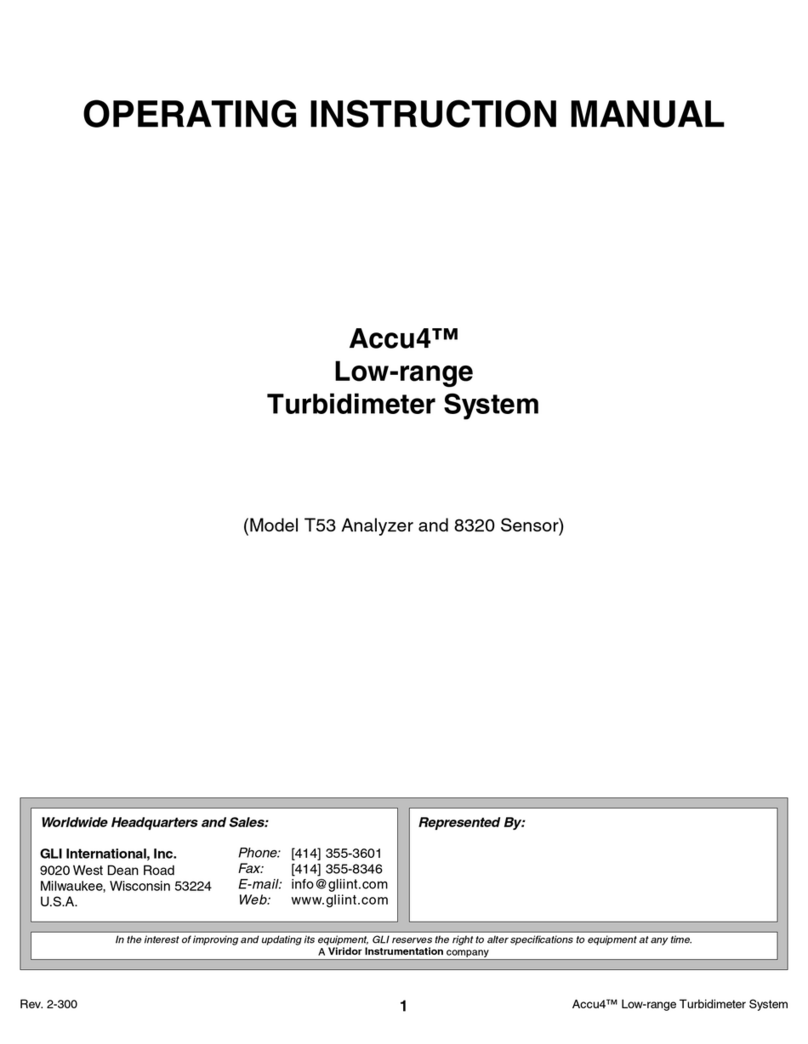
GLI International
GLI International Accu4 Instruction Manual

GLI International
GLI International GLI-98144 User manual

GLI International
GLI International GLI-93711 User manual
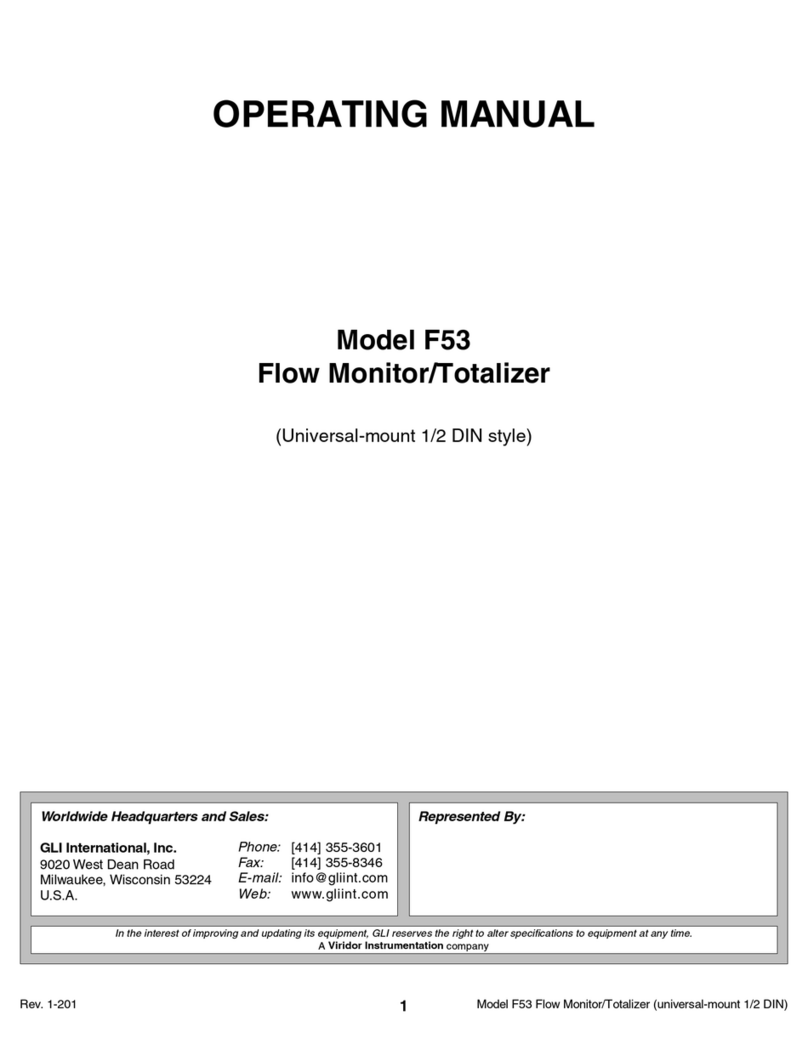
GLI International
GLI International F53 User manual
